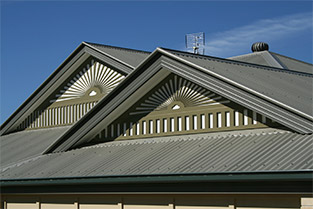
Sustainable Low-Slope Roofing
ASTM International Committee D08 on Roofing and Waterproofing, through its Subcommittee D08.24 on Sustainability, is developing several standards for sustainable roofing systems. One such standard is WK26599, Guide for Design of Sustainable, Low-Slope Roofing Systems.
"The proposed standard embraces the fact that the primary purpose of the roofing system is to protect the top of the structure from weather over the course of the roof's design life, and taht sustainable considerations such as use of the roof for water collection, vegetation, photovoltaics or use of newer or recycled products deemed environmentally friendly must not sacrifice this key aspect. does not specify materials or products," says Eric Olson, consulting engineer, Simpson Gumpertz & Heger Inc.
Olson notes that the proposed standard does not specify materials or products. "Rather, it serves as a guide encompassing numerous varieties of low slope roofing systems. One of the objectives of WK26599 is to encourage the designer to select a roofing system optimized for its environment and for requirements an end-user may have for the roof. For example, an end-user may want to mount a photovoltaic array on the roof. The roof must be sufficiently robust to take any added weight and abuse that maintenance of an array will subject it to, while protecting the top of the building from the weather with little unplanned intervention for the duration of its design life"
WK26599 describes the process by which a designer or specifier looks at the demands and factors that a low-slope roofing system must be capable of withstanding. External factors include wind, weather, rainfall, chemical exposure, foot traffic and use under vegetation. Building pressurization and interior humidification are among internal factors to be considered.
"Specifying a roof based solely on perceived environmental friendliness without considering the roof's suitability for its intended purpose and the demands the roof will be subjected to may require the roof's replacement at an early age, which is not very sustainable," says Olson.
Olson notes that the proposed standard is intended for roofing system designers and specifiers, though end users and purchasers may find it useful in guiding their decisions regarding selection of an appropriate roofing system and understanding risks that come from selection of a less suitable system.
According to Olson, WK26599 was developed with consideration for other industry sources regarding sustainable roofing practice. One such source is the RoofPoint Rating System developed by the Center for Environmental Innovation in Roofing. Another is CIB (International Council for Research and Innovation in Building and Construction) Publication 271, Towards Sustainable Roofing, which includes the three key tenets of sustainable roofing that serve as the foundation for WK26599:
- Minimize the burden on the environment,
- Conserve energy, and
- Extend roof lifespan.
Interested parties are encouraged to join in the standards developing activities of D08.24. In addition to WK26599, the subcommittee is developing the following proposed standards:
- WK24614, Guide for Recycling Practices and Reporting Methodology;
- WK26595, Guide for Roof System Durability;
- WK26596, Practice for (Product Category Rule) for Preparing Environmental Product Declarations of Low Slope Roofing Membranes;
- WK29304, Guide for Selection of Roofing/Waterproofing Membrane Systems for Vegetative (Green) Roof Systems; and,
- WK41167, Guide for the Durability of EPDM Roofing Membranes.
CONTACT Technical Information: Eric K. Olson, P.E., Simpson Gumpertz & Heger, Waltham, Mass. • Phone: 781-907-9311 | ASTM Staff: Joseph Hugo • Phone: 610-832-9740 | Upcoming Meeting: Dec. 8-11 • December Committee Week • Jacksonville, Fla.
 SN Home
SN Home Archive
Archive Advertisers
Advertisers Masthead
Masthead RateCard
RateCard Subscribe
Subscribe Email Editor
Email Editor